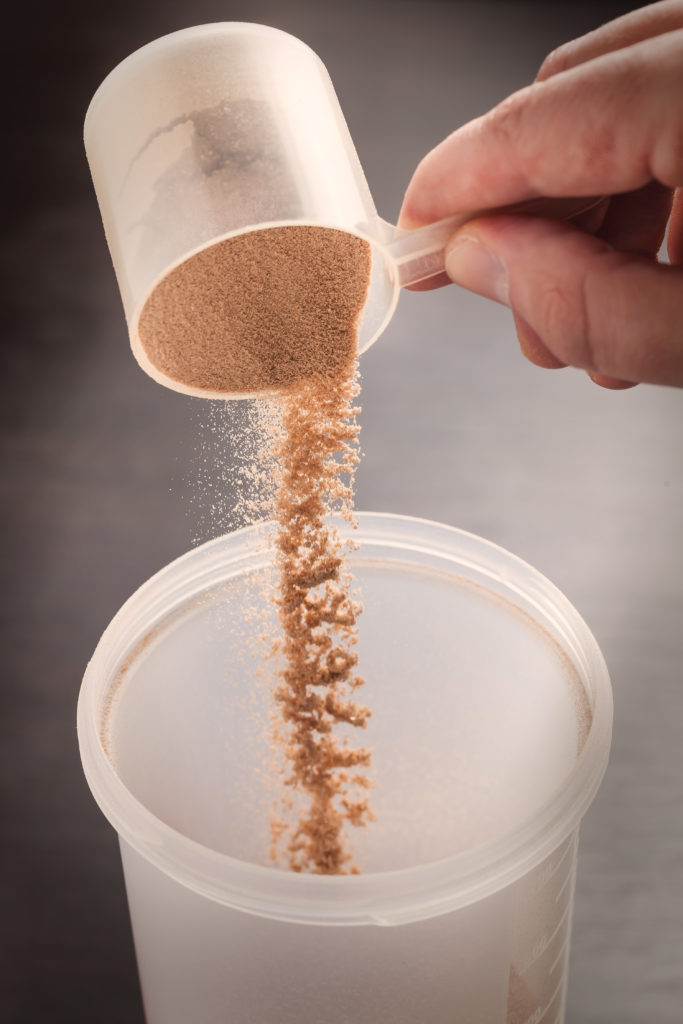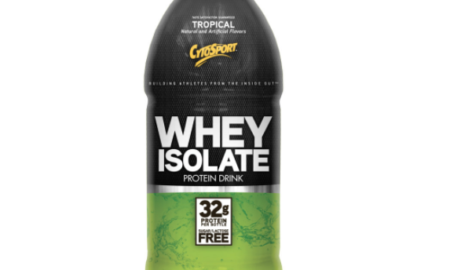

Trip your anabolic ignition switch with the right nutritional choices after a workout
By George L. Redmon PhD
All of the body’s important recovery and adaptive processes require specific nutrients to proceed optimally. For this reason, the period immediately following a workout is the most important in an athlete’s day from a nutritional perspective. Failure to consume adequate amounts of the right nutrients in a timely manner after exercise will compromise your recovery.
—The Performance Zone by Dr. John Ivy and Dr. Robert Portman
Thanks to work by renowned sports medicine researcher John Ivy, PhD, at the University of Texas, and well-known researcher Robert Portman, PhD, we know that post-workout recovery is the key to stimulating growth. The reason cited by these researchers is that the body machinery necessary for rebuilding and replenishing energy stores and repairing damaged muscle becomes overwhelmed. However, sports nutrition researchers now know that an anabolic window of opportunity is open for 30 to 45 minutes following a training session in which you can bolster this machinery. In fact, current data indicates that the muscle cells’ potential to initiate rebuilding and replenishment peaks about 15 minutes after a workout and declines by as much as 40 percent within 60 minutes. The reason: Intense exercise training causes muscle fatigue; soreness; dehydration; muscle structural damage; free radical damage; lactic acid buildup; neutrophilia (increase in white blood cells that fight infection/harmful bacteria); muscle swelling; central nervous system fatigue; catabolism of nutrient stores; counter-regulatory hormones; increased metabolic instability; and the destruction of carbohydrate, fat, and protein.
Simultaneously, many other things are happening during this impending catabolic time-frame, such as the depletion of muscle glycogen, release of amino acids from muscle, stimulated liver gluconeogenesis, and negative nitrogen balance. As a note here, gluconeogenesis is the production of glucose, especially in the liver, from amino acids, fats, and other substances that are not carbohydrates. In this case, amino acids and other nutrients are not being used for growth and repair, which is not what should be occurring at post-workout. Correspondingly, negative nitrogen balance physiologically diminishes your ability to sustain muscle growth. Equally, researchers state that post-exercise muscle recovery, repair, and growth ultimately determines the benefits of exercise to the development of lean body mass, but is reliant on glucose, amino acids, and energy availability for optimal rates of muscle glycogen and protein synthesis. Some other things your nutritional recovery plan should focus on are reducing muscle soreness, rebuilding and repairing muscle, re-establishing immune function, protecting the skeletal matrix, and minimizing fat storage. What is important to remember here is that your workout in practical terms acts like a priming pump, converting your body into a giant sponge, heightening your capability to soak up nutrients quickly and efficiently. You have about 30 minutes before the force of this pump’s action begins to dissipate.
The goal here is to present a basic nutritional recovery plan based on current data that focuses on re-establishing some of the physiological parameters cited above.
Your Basic Recovery Plan Of Action

- Decreased Protein Breakdown: Research from the University of Nottingham showed that acute bouts of resistance exercise can increase the rate of muscle protein synthesis two- to fivefold after exercise, and this effect can persist for up to 48 hours. However, at the other end of the spectrum, protein breakdown continues to increase dramatically. Relatedly, in a study appearing in the International Journal of Sports Nutrition Exercise and Metabolism researchers noted that the consumption of 20 grams of protein, or an equivalent of nine grams of essential amino acids, has the ability to maximize muscle protein-synthesis rates during the first hours of post-exercise recovery. As a note here, whey protein is a faster-acting protein and speeds recovery faster than other protein sources as it releases amino acids in about 20 minutes. Furthermore, whey is abundant in leucine, the key amino acid that signals the mammalian target of rapamycin (mTOR) anabolic pathway to increase protein synthesis. However, new data indicates that a single individual dose of leucine is even more efficient at signaling this anabolic pathway. For best results, following a workout, consume 20 to 25 grams of whey and 2.7 grams of leucine.
- The Carbohydrate Glycogen Axis: Once consumed, carbohydrates break down into glucose and serve as a critical source of energy to sustain your muscle’s contractile power. How long this energy supply lasts depends on the length and intensity of exercise and can range anywhere from 30 to 90 minutes. For example, during high-intensity strength training sets lasting one to three minutes, muscle glycogen supplies about 95 percent of the fuel needed to complete this work. If you’re training for strength, performance, hypertrophy, or conditioning, it’s important to start your routine with full glycogen stores, and possibly even replenish them during your training to maintain the quality of your output.

Carbohydrates have other specific functions in the body including fueling the central nervous system and the brain. Long ago, Nathan Smith, MD of the University of Washington and author of Food For Sport, noted that the constant supply of carbs to the brain was essential for an optimal sense of awareness and quick reflexes to support athletic performance. However, more importantly, Smith found that an inadequate supply of glucose, particularly to the central nervous system, caused feelings of weakness and hunger. Today, sports medicine researchers know that muscle fatigue first starts in the central nervous system (CNS) even before you feel muscular fatigue. Research on central nervous fatigue has shown a direct correlation between the brain chemicals serotonin (5-HT), dopamine and acetylcholine and the onset of CNS fatigue.
By the way, acetylcholine is released in the peripheral nervous systems to activate muscle fibers. Correspondingly, decreased levels of acetylcholine leads to noticeable muscle fatigue and a decrease in muscle strength. Current data shows that carbohydrates and branched chain amino acids) have a direct impact on the brain chemicals serotonin and dopamine, by delaying the onset of central nervous system fatigue due to their influence on amino acids such as tryptophan, which directly affect the levels of serotonin and dopamine in the brain.
It has long been common practice to consume a post-workout protein and carbohydrate beverage to spike insulin, which in turn drives nutrients into the cells at a faster rate to speed muscle recovery. According to researchers at the School of Sport and Exercise Sciences of the University of Birmingham in Edgbaston, Birmingham in the UK, exercise signals what scientist call glucose transporter carrier protein-4 to the cell surface. This leads to an increased permeability of the muscle membrane to accept glucose. However, when this small window of opportunity following a workout that up-regulates this phase of glycogen synthesis closes, muscle glycogen synthesis occurs at a much slower rate, meaning several hours. As you may know, insulin escorts nutrients into cells, and for some time researchers believed that simple carbs (high-glycemic) that break down quickly and rapidly were best suited to elicit an insulin spike. However, researchers now know that low-glycemic carbs, which break down at a slower pace and don’t initiate huge spikes of insulin at post-workout, are just as effective. As a note, one of the negatives of constant high spikes of insulin via simple carbs is an increase in fat storage, as insulin acts like a key that locks fat in the cells.
While insulin does escort amino acids and nutrients into the cell, it also increases net protein balance by reducing muscle protein degradation. In their book The Performance Zone, Ivy and Portman stated that insulin within the anabolic window also stimulates enzymes necessary for protein synthesis by as much as 67 percent, while suppressing cortisol production and increasing muscle blood flow. This apparently speeds the flow of nutrients to weak and tired muscles as well as enhanced removal of waste (lactic acid, carbon dioxide) and puts the brakes on muscle wasting.
- First Meal At Post-Workout: Once your workout is complete, you should have a whole-food meal within an hour or two. Some evidence suggests that that a meal of 40 percent protein, 40 percent carb, and 20 percent fat can yield phenomenal results. Conversely, other researchers suggest a smaller ratio of fat for this meal, as excess fat during this time may slow the delivery of nutrients into the muscle cells. Essentially, this meal helps your body use the all of the circulating free fatty acids that have been pumped out into the bloodstream. Unless these fats are transported to the liver and muscle for final utilization, they can be arbitrarily reconverted back into triglycerides and redeposited back into fat tissues.























You must be logged in to post a comment Login